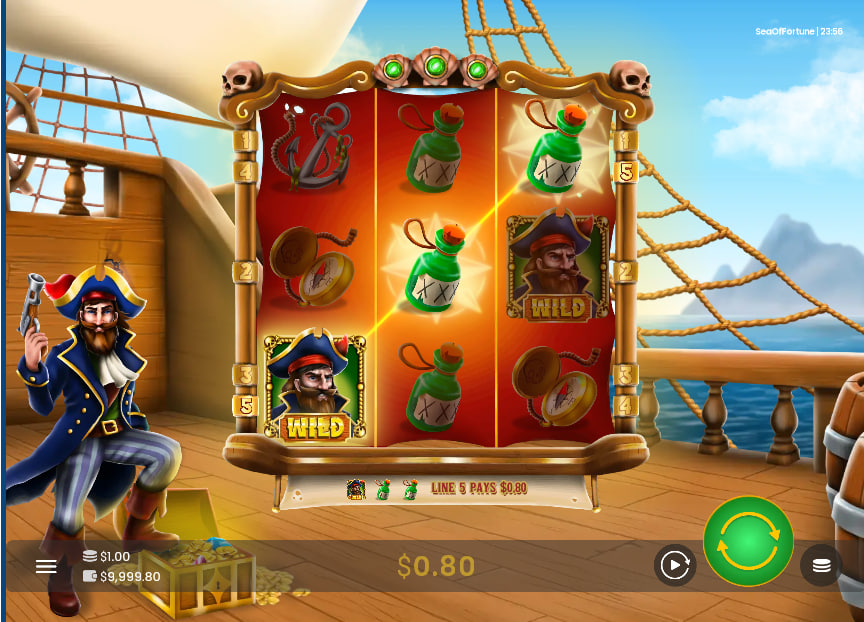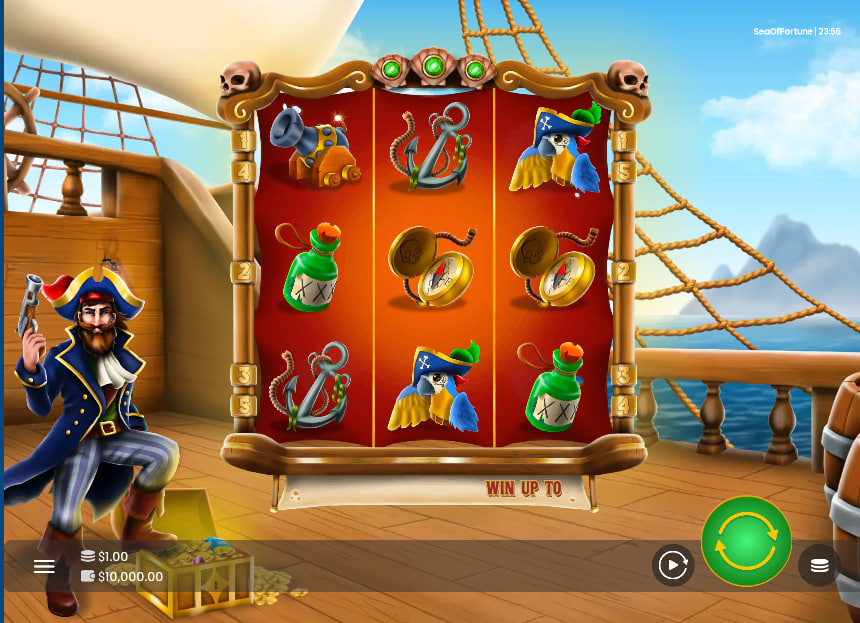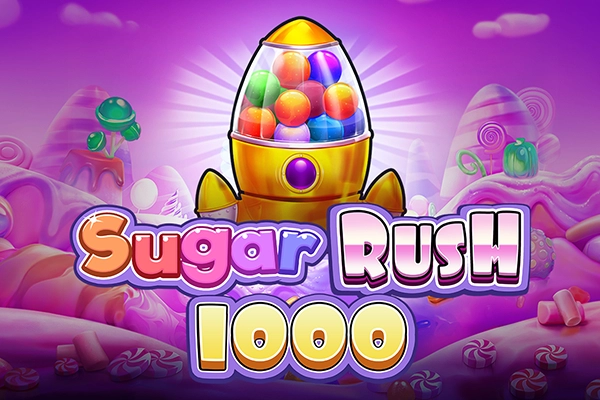FBM’s Sea of Fortune presents a modern pirate theme on a classic 3×3 layout. The game’s atmosphere is bright and clean, utilizing a contemporary graphic style rather than a gritty, realistic depiction of piracy. Its core gameplay loop revolves around a fast-paced, 5-payline structure. What sets this game apart is its complete deviation from scatter-based triggers for its main features. The primary BONUS Mode is a randomly activated respin feature where players collect sticky symbols for a final multiplier of up to 20x. This is complemented by a Wild Injection Mode, another random event that adds wilds to the reels for increased winning potential. With a medium volatility model, the game offers a balanced risk-to-reward profile. The slot operates with a high theoretical RTP of 96.89%. This design creates a session defined by constant anticipation, appealing to players who appreciate innovative trigger mechanics.
FBM Digital Systems brings a distinct approach to the crowded field of pirate-themed games with Sea of Fortune. At first glance, its 3×3 reel structure and five paylines suggest a return to classic, simplified slot mechanics. However, this initial impression is misleading. The game’s core design pivots away from conventional scatter-based triggers, instead building its primary gameplay excitement around two randomly activated base game features. This decision, combined with a high theoretical RTP of 96.89%, creates a gameplay dynamic that merits a closer look, particularly for seasoned players familiar with standard slot frameworks. The game eschews complexity in its layout to concentrate all its innovation on how its most impactful moments are initiated.

Anatomy of the Bonus Mechanics and Random Events
The primary element that distinguishes Sea of Fortune is its complete reliance on random triggers for its major features. There are no scatter symbols to collect or progress bars to fill. Instead, the gameplay is punctuated by two powerful, randomly occurring events: the Wild Injection Mode and the main BONUS Mode. This design choice fundamentally alters the rhythm of play, creating a sustained level of anticipation on every single spin, as any turn could potentially activate a significant feature without prior visual indication.
The cornerstone of the game is the BONUS Mode, a feature that activates unpredictably on any given spin. Its structure will be familiar to players acquainted with Hold & Win mechanics, though it incorporates a critical final-stage multiplier. Upon activation, the game randomly selects one of the standard paying symbols (Anchor, Compass, or Bottle). The game grid then clears of all other symbols, and a sequence of three respins begins. During these respins, only the chosen symbol, Wild symbols, and blank spaces will appear on the reels. When a chosen symbol or a Wild lands, it becomes sticky, locking in place for the remainder of the feature. Crucially, each time a new symbol locks onto the grid, the respin counter resets to three. This cycle continues until either the grid is completely filled with symbols or three consecutive respins occur with no new symbols landing.
The conclusion of the BONUS Mode is where its full potential is realized. Once the respins are complete, the game calculates the total value of all winning combinations formed by the sticky symbols on the five paylines. This total is then multiplied by a randomly determined value: 4x, 8x, 12x, 16x, or a substantial 20x.
Complementing the main bonus is the Wild Injection Mode. This is a more direct, yet still impactful, base game modifier that also triggers randomly. When activated, the game executes a brief animation where the pirate character on the left side of the screen fires his pistol, causing a number of Wild symbols to be added to the reels in random positions before they come to a stop. This feature serves to break up periods of standard spins and can turn a non-winning or low-paying spin into a valuable one, especially by creating multiple five-payline hits with the high-value Wild symbol.
Visual Presentation and Thematic Execution
While the pirate theme is a well-established trope in online slots, FBM's execution in Sea of Fortune leans towards a clean, modern aesthetic rather than a gritty, realistic portrayal. The art style is reminiscent of contemporary mobile games, utilizing bold lines, vibrant colors, and a clear, almost vector-like quality. This gives the game a bright, approachable feel that stands in contrast to the darker, more detailed art seen in many competing titles. The symbols—a weathered anchor, a brass compass, and a message in a bottle—are rendered with clarity and are instantly recognizable.
The setting is the deck of a pirate ship, with the ocean and distant islands visible in the background. The most dynamic visual element is the animated pirate captain who stands to the left of the reels. He is not a static illustration; he idles, reacts to wins with a celebratory gesture, and plays a central role during the Wild Injection feature animation. This character adds a layer of personality to the proceedings. The user interface is cleanly integrated at the bottom of the screen, maintaining the uncluttered presentation. Animations for winning paylines are straightforward, highlighting the symbols involved without excessive visual noise, which aligns with the game's overall design philosophy of functional clarity over decorative excess. The spin of the reels, fashioned as a ship's sail, is a subtle but well-integrated thematic touch.

Core Gameplay Loop and Symbol Interactions
The foundation of Sea of Fortune is its 3×3 grid and 5 fixed paylines. This classic format inherently creates a faster-paced session compared to larger 5×5 or Megaways grids. Payouts occur for three matching symbols on a line, from left to right. The game's symbol hierarchy is concise, which is appropriate for a 3-reel system. The paytable consists of just four primary symbols: three standard paying icons and the Pirate Wild.
The Pirate Wild symbol is the most valuable asset in the game. It not only substitutes for all other symbols to help form winning combinations but also carries the highest standalone payout value. The interplay between the small number of symbols and the game's stated medium volatility is noteworthy. While the 3×3 grid can produce frequent blank spins, the limited symbol variety means that when symbols do land, the probability of forming a winning line is reasonably high. The core gameplay loop, therefore, becomes a pattern of quick spins, punctuated by the constant potential for one of the two random features to interrupt the standard flow. This structure ensures that even the base game avoids becoming monotonous, as the anticipation is not tied to landing specific symbols but to a random system event.
FBM Digital Systems, the developer behind Sea of Fortune, has a history rooted in the land-based gaming market, particularly with bingo machines. Their transition into the online slot sector has been marked by games that often blend classic formats with one or two powerful, distinguishing features. This background seems to influence their design philosophy, which prioritizes potent, easily understood mechanics over overly convoluted systems. Sea of Fortune is a clear product of this approach, building an entire experience around its random trigger system. This focus allows the game to present something mechanically different without overwhelming the player. For individuals who play free slots online to understand game mechanics before committing, this title provides a clear case study in how random-trigger bonuses can alter the traditional slot experience.













